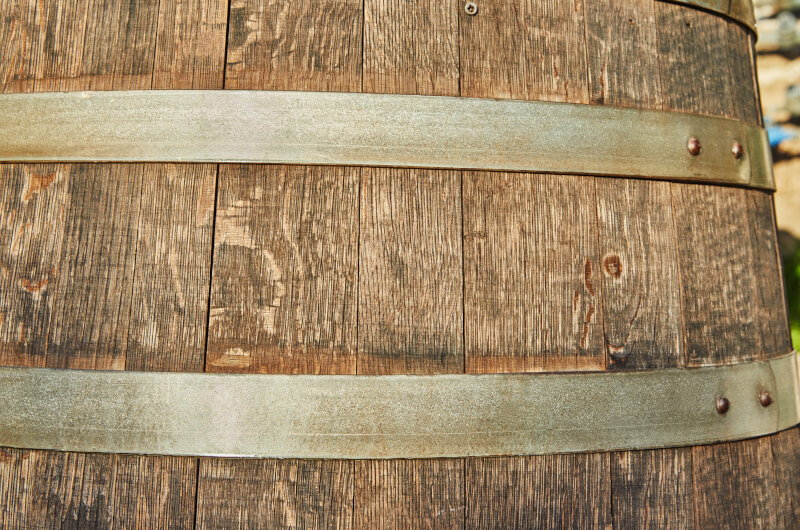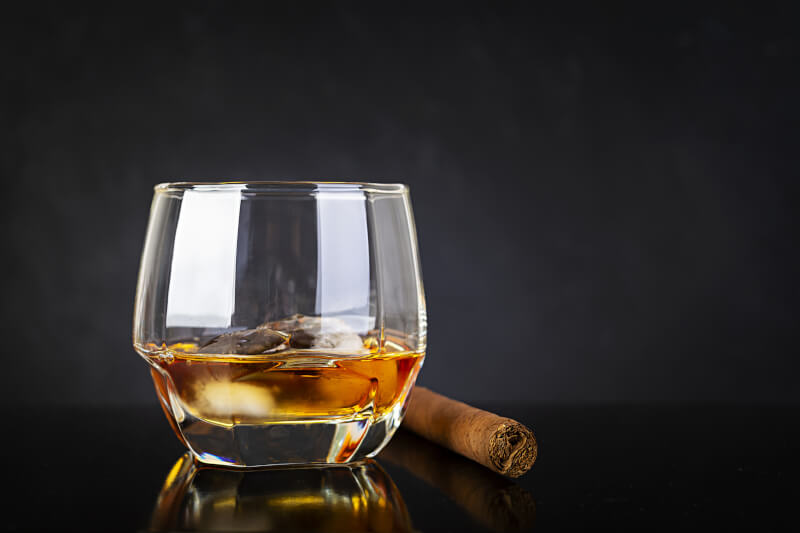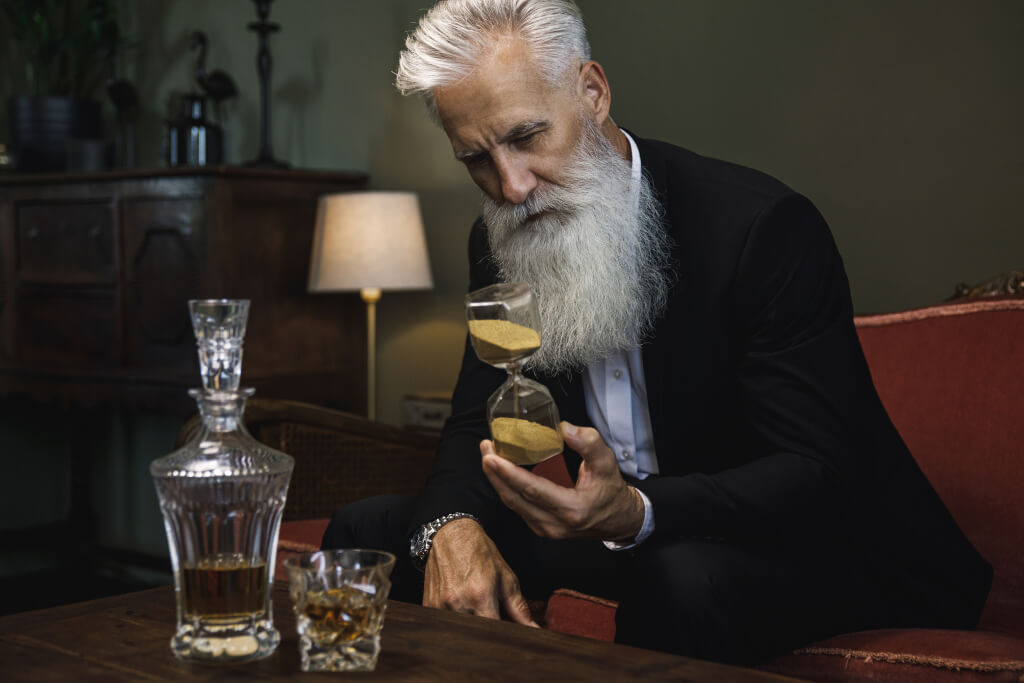The Secrets of Maturation Revealed
The essential process of maturing transforms whiskey from a simple mixture of grains, water, and yeast into a symphony of flavors and sensations. The aging process gives whiskey its distinctive flavor and aroma, which can range from intense smokiness to surprisingly bright notes of fruit, spice, and more. Maturation gives whiskey its soul, its distinctive character that attracts fans from all over the world.
Barrels of Time
To whet your appetite, consider this tantalizing morsel: Did you know that once a whiskey is bottled, it doesn’t mature no matter how long it sits on a shelf? whiskey, unlike wine, is aged entirely in the barrel; the spirit in the bottle remains the same age as it was when it was bottled. A 12-year-old Scotch will retain its identity whether it is poured now or in the next decade. Interesting, wouldn’t you say? Join us as we explore the magical process of whiskey aging, the key to appreciating its exquisite flavor.
A Brief History
The Development of Whiskey Over Time
The history of whiskey is as deep and intriguing as the drink itself. The distillation process, known as “usquebaugh” or “water of life,” was developed in Celtic countries like Ireland and Scotland as a way to creatively utilise surplus grains. But what is it about becoming older that seems so magical? That turned out to be a happy accident. whiskey back in the day was generally consumed when it was still young and transparent, hence the name ‘white spirits’. People only noticed the change when it was transported in oak casks, which was a necessary but inconvenient step. Over time, the spirit’s contact with the wood mellowed its initial harshness and added a complex bouquet of flavors and a warm amber colour. This led to the development of aging whiskey, which revolutionised the alcohol industry.
From the Abbey to the Bootlegger’s Still
Exciting anecdotes about whiskey across time serve to illustrate the value of aging. One of the earliest groups to recognize the benefits of aging spirits in a cool, dark place was the monks of medieval monasteries. A fanciful concept inspired the moniker “Angel’s Share” to describe the part of whiskey that evaporates during the aging process. The employees of the warehouse discovered the missing whiskey and joked that the angels must have stolen it. The history of whiskey aging is an intriguing adventure, from tales of Prohibition-era moonshiners experimenting with different aging techniques to tales of smugglers aging their whiskey in seawater-soaked casks, giving it a distinctive salty character.
Maturational Science

Understanding Whiskey Aging
At its essence, maturation refers to the time that whiskey spends resting in a barrel. Don’t be deceived by its apparent inactivity; this process is a hive of chemical activity. The spirit’s final character is shaped while it ages in the cask by a combination of compounds absorbed from the wood, oxidation, and the loss of some constituents through evaporation. During this time, the once raw and fiery spirit mellows and accumulates a delicate bouquet of flavors and smells, maturing into the subtle, sophisticated whiskey we love.
Where Chemistry Meets Art
The aging process is a brilliant display of chemical orchestration. whiskey is aged in oak barrels, where it absorbs compounds like lignin (which adds sweetness and vanillin flavors) and tannins (which contribute colour and mouthfeel), while also undergoing oxidation (also known as the “Angel’s Share”), which helps to mellow the spirit, and evaporation, which can affect the whiskey’s overall concentration and character. Each whiskey has its distinct flavor and scent because of the many chemicals formed during the distillation process at the same time.
The Importance of the Barrels in Giving Whiskey Its Unique Flavor
The story of maturation revolves largely around the type of barrel utilised. Caramel, vanilla, and coconut notes are commonly imparted by American oak barrels because of their high vanillin concentration, while spicy, nutty, and dried fruit notes are typically imparted by European oak. Bourbon barrels’ charred interiors offer a delicious smokey richness to the spirit, while Sherry casks’ rich sweetness complements the spirit’s natural dark fruit and chocolate notes. whiskey is matured in a variety of barrels, each of which contributes its flavor profile to the process and helps shape and refine the spirit as it matures. Isn’t it cool to learn about how whiskey develops?
Climate’s Role in Developing The Aging Process
whiskey aging doesn’t occur just within the confines of a climate-controlled warehouse. The spirit’s internal conversation with its environment plays a significant role in moulding its personality. Whiskies from diverse parts of the world, each with its distinctive climate, have their personality. Whiskey’s backstory includes locations as diverse as the mild rains of Scotland, the lush countryside of Ireland, and the ever-changing weather of Kentucky.
The Bluegrass Region of Kentucky to the Highlands of Scotland
Spirits typically mature slowly in the Scottish Highlands due to the climate, allowing the spirit to slowly extract flavors from the barrel. This lengthy procedure typically yields whiskies of exceptional complexity and harmony. Irish whiskies have a reputation for being light and smooth because they are aged in the country’s mild, constant climate, which allows the grains used to make the spirit to impart only the faintest of flavors.
On the other hand, the spirit interacts with the wood more actively in Kentucky’s hot summers and cold winters, speeding up the maturation process. During the warmer months, the spirit travels deep into the barrel, picking up rich, strong flavors; during the cooler months, it retreats to the surface. This produces Bourbon with the classic caramel and vanilla flavors, plus a hint of wood.
The Importance of Relative Humidity in the Aging Process
whiskey aging is aided or hindered by humidity. Spirits with a higher proof and a rich, fruity flavor tend to be produced in humid climates, such as those found in some regions of Ireland. On the other hand, in regions with lesser humidity, like those of Scotland or Kentucky, less water evaporates, leading to a lower-proof spirit that may better exhibit the oak’s characteristics.
Whiskey Tasting: A Fine Art
How to Tell Your Age by What You Smell and Taste
Like delving further into a captivating novel with each drink, the flavor and aroma of matured whiskey reveal the story of its maturation. In contrast to its youthful sharpness, aged whiskey generally develops a deep and nuanced flavor profile, with a rich tapestry of flavors coming to the fore. Older whiskies sometimes have a complex bouquet of smells on the nose, including ripe fruit, spices, oak, and even an earthiness that betrays their age. Look for complexity and a nice harmony of flavors on the palate, the result of a slow dance with the barrel.
How to Taste and Enjoy Old Whiskey
Aged whiskey tasting can be a fascinating adventure for whiskey novices. You can tell how old something is just by looking at its colour, so take your time getting started. Then, give it a light sniff to figure out what sounds you’re picking up. How fruity is it? Spicy? Woody? Take a drink and savour it by allowing it to linger in your mouth. Keep in mind that there is no definitive answer; rather, this is an opportunity to develop your sense of taste. Finally, take your time; a fine whiskey needs time to reveal its full splendour.
Myths About Whiskey Aging

The Age-Old Fallacy
There is a common misconception that older whiskey is better whiskey. Intriguing depth and complexity may be found in a whiskey that has matured for some time, but it’s vital to remember that there are other aspects besides time in the barrel that contributes to a whiskey’s overall quality. Crucial factors include the ingredients, method of distillation, type of barrel, and maturation conditions. The flavor profile of some whiskies may be at its peak after less time in barrels than others. The key is harmony!
From the Still to the Bottle
whiskey, in contrast to wine, does not improve with further aging once bottled. whiskey undergoes its aging process in the barrel, where it interacts with the wood and the atmosphere. Once bottled, the spirit stops changing and preserves its original qualities.
What the Future Holds
Experiments and Developments in the Next Phase of Aging
There is no respite for the whiskey industry, and the prospects for whiskey aging in the future are exciting. Distillers that want to get their products to market faster are experimenting with accelerated aging techniques. To speed up the aging process, some distilleries use pressure or high-frequency sound waves to increase the amount of time the spirit spends in touch with the wood, to achieve a more mature flavor profile in a shorter amount of time. These methods may cause controversy among purists, but they’re fascinating to see anyway.
The use of unconventional barrel designs is also gaining popularity. These novel endeavours, which range from using barrels made from unusual woods to those seasoned with wine, beer, or even tea, breathe new life into the whiskey flavor story.
Whiskey Aging Favourites of the Future
Sustainability is expected to play a larger part in whiskey aging in the future, according to experts. Barrels will be reused, sustainable wood will be sourced, and distilleries’ environmental footprints will be reduced as these practices become the norm. It’s possible that terroir, the concept that distillers should appreciate the special qualities that their regions’ climates and resources give their products, may gain popularity.

